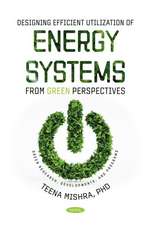Evaluation Method of Energy Consumption in Logistic Warehouse Systems: EcoProduction
Autor Pawel Zajacen Limba Engleză Hardback – 23 sep 2015
| Toate formatele și edițiile | Preț | Express |
|---|---|---|
| Paperback (1) | 634.68 lei 43-57 zile | |
| Springer International Publishing – 22 oct 2016 | 634.68 lei 43-57 zile | |
| Hardback (1) | 640.71 lei 43-57 zile | |
| Springer International Publishing – 23 sep 2015 | 640.71 lei 43-57 zile |
Din seria EcoProduction
- 18%
 Preț: 999.60 lei
Preț: 999.60 lei - 15%
 Preț: 637.59 lei
Preț: 637.59 lei - 15%
 Preț: 644.18 lei
Preț: 644.18 lei - 24%
 Preț: 1137.30 lei
Preț: 1137.30 lei - 18%
 Preț: 783.81 lei
Preț: 783.81 lei - 18%
 Preț: 963.47 lei
Preț: 963.47 lei - 19%
 Preț: 554.19 lei
Preț: 554.19 lei - 15%
 Preț: 637.59 lei
Preț: 637.59 lei - 18%
 Preț: 964.71 lei
Preț: 964.71 lei - 15%
 Preț: 645.28 lei
Preț: 645.28 lei - 15%
 Preț: 643.48 lei
Preț: 643.48 lei - 18%
 Preț: 946.55 lei
Preț: 946.55 lei - 20%
 Preț: 644.48 lei
Preț: 644.48 lei - 15%
 Preț: 644.18 lei
Preț: 644.18 lei - 15%
 Preț: 590.30 lei
Preț: 590.30 lei - 18%
 Preț: 722.75 lei
Preț: 722.75 lei - 18%
 Preț: 944.36 lei
Preț: 944.36 lei - 15%
 Preț: 641.53 lei
Preț: 641.53 lei - 15%
 Preț: 646.30 lei
Preț: 646.30 lei - 15%
 Preț: 646.11 lei
Preț: 646.11 lei - 18%
 Preț: 945.79 lei
Preț: 945.79 lei - 18%
 Preț: 1006.87 lei
Preț: 1006.87 lei - 18%
 Preț: 785.86 lei
Preț: 785.86 lei - 18%
 Preț: 999.60 lei
Preț: 999.60 lei - 15%
 Preț: 644.95 lei
Preț: 644.95 lei - 18%
 Preț: 788.41 lei
Preț: 788.41 lei - 15%
 Preț: 646.94 lei
Preț: 646.94 lei - 24%
 Preț: 783.26 lei
Preț: 783.26 lei -
 Preț: 389.11 lei
Preț: 389.11 lei
Preț: 640.71 lei
Preț vechi: 753.77 lei
-15% Nou
Puncte Express: 961
Preț estimativ în valută:
122.64€ • 133.26$ • 103.08£
122.64€ • 133.26$ • 103.08£
Carte tipărită la comandă
Livrare economică 21 aprilie-05 mai
Preluare comenzi: 021 569.72.76
Specificații
ISBN-13: 9783319220437
ISBN-10: 3319220438
Pagini: 140
Ilustrații: XVIII, 158 p. 45 illus., 26 illus. in color.
Dimensiuni: 155 x 235 x 17 mm
Greutate: 0.43 kg
Ediția:1st ed. 2015
Editura: Springer International Publishing
Colecția Springer
Seria EcoProduction
Locul publicării:Cham, Switzerland
ISBN-10: 3319220438
Pagini: 140
Ilustrații: XVIII, 158 p. 45 illus., 26 illus. in color.
Dimensiuni: 155 x 235 x 17 mm
Greutate: 0.43 kg
Ediția:1st ed. 2015
Editura: Springer International Publishing
Colecția Springer
Seria EcoProduction
Locul publicării:Cham, Switzerland
Public țintă
ResearchCuprins
Introduction.- Thesis.- Literature overview.- Methods to assess the energy consumption of LSM.- Experimental research results.- Verification of the model evaluation of LSM.- Summary and conclusions.- Utilitarian results.- Literature.
Textul de pe ultima copertă
This book focuses on guidelines for reducing the energy consumption in warehousing processes. It presents a model of formal assessment for energy consumption in the context of storage-system logistics, as well as a computational model consisting of three sub-models: energy consumption models for forklifts and stacker cranes, respectively, and an energy intensity model for roller conveyors. The concept model is based on the assumption that the unit load is received at a zero-energy warehouse. Subsequent handling, transport and storage processes, in which the unit load is moved vertically and horizontally through the system, equate to changes in energy intensity within the logistics warehouse management system. Energy recovery based on the handling equipment used can be collected in batteries. The evaluation method takes into account the intensity of the energy supplied to the logistics system and reduces the storage of the recovered energy - this figure represents the energy needed to pass through the logistics unit load storage system, and can be expressed in an energy intensity map.
Caracteristici
Provides guidelines for reducing the energy consumption in warehousing processes Presents the evaluation method which takes into account the intensity of the energy supplied to the logistics system Eliminates energy waste - this is the "lean" in warehousing Includes supplementary material: sn.pub/extras

















